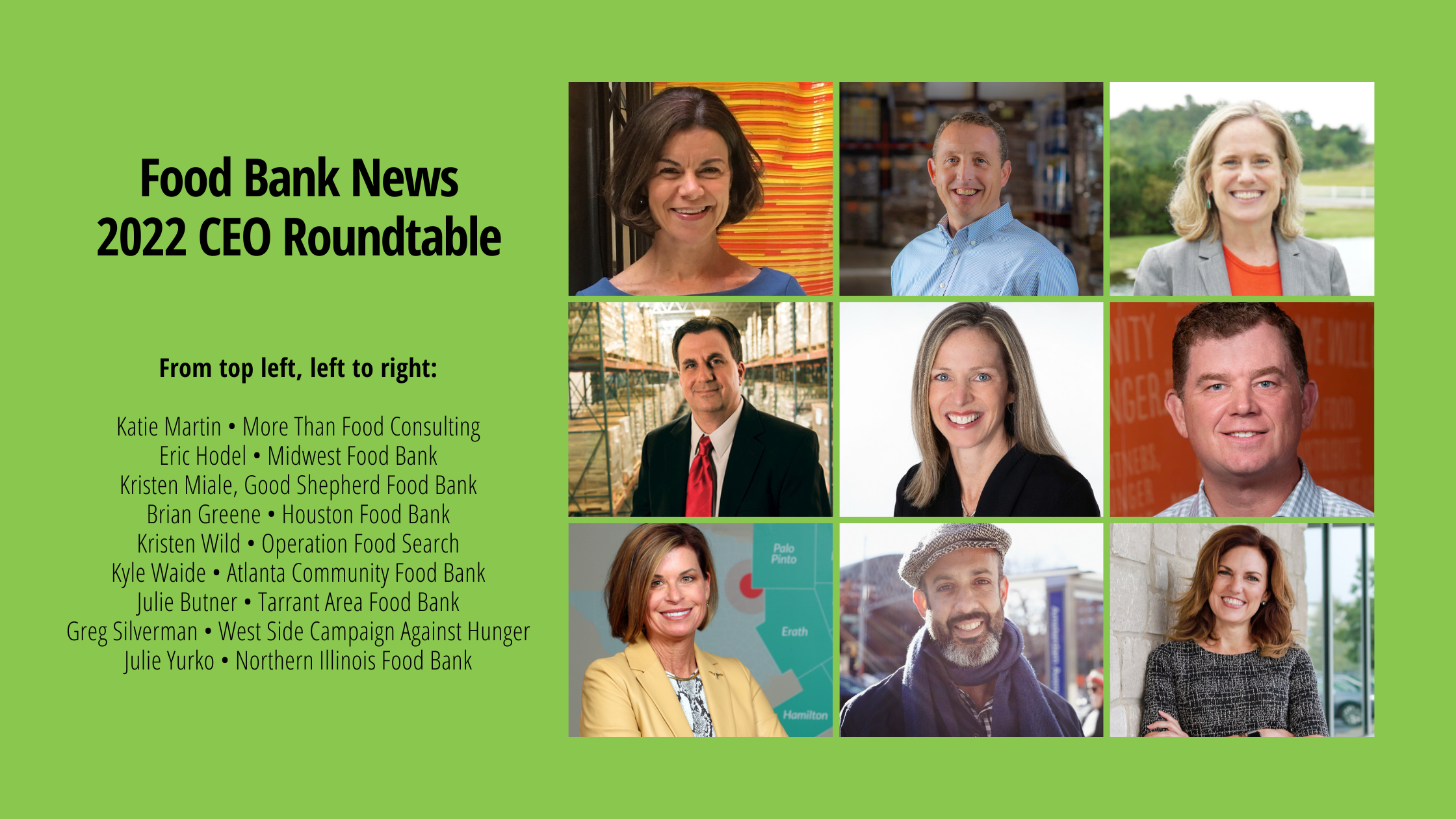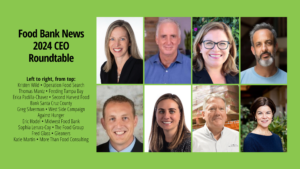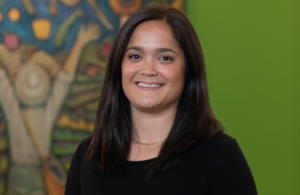The ability of food banks to keep up with the ongoing demand for food is easily one of their biggest accomplishments of recent years. After the frenzy of the pandemic settled, millions more people than before the pandemic continued to access charitable food. And rising inflation has kept demand uncomfortably high.
While the relentless demand for food may be draining, food bankers also recognize the currency that comes with being able to meet the need. “It’s our ticket to the game,” said Brian Greene, President and CEO of Houston Food Bank, during Food Bank News’ third annual CEO Roundtable Discussion. “It’s our relevance.”
Moving food is what gives food banks the opportunity to do so much more, whether that’s signing people up for non-food assistance, improving community health through nutritious meal deliveries, or reversing the impact of food deserts.
“Food banks started to realize that we have a lot of ability that we were overlooking when we were so busy getting food out the door,” Greene said, adding, “But the ability of food banks to make things happen is really powerful.”
Food banks are connectors
Food easily brings people together, which makes food banks natural conveners, the CEOs agreed. As an example, Northern Illinois Food Bank has formed Neighbor Councils in which it gathers a cross-section of seven to ten clients to get their input on a host of considerations, such as how to make food distributions more accessible and how to measure whether it’s doing a good job.
“There’s a lot of authenticity and intentionality behind listening more to our neighbors versus just being focused on serving them or trying to change their circumstances,” said Julie Yurko, President and CEO of Northern Illinois Food Bank. “Decisions are being made with their input, not for them.”
Good Shepherd Food Bank is empowering communities through a program that gives large grants to community groups and wide latitude in how to use them (see more here). The focus is on community groups of color that have not benefitted from traditional funding sources. “We’re using our convening capacity and our funding capacity in a very different way to support community organizations that are building food security among themselves,” said Kristen Miale, President of Good Shepherd Food Bank. “We provide the funding, but those community members make all the funding decisions.”
Data will transform equity work
Greene noted that food banks have historically operated under a “path of least resistance,” leading them to send food to places that are already well-resourced with things like volunteers, pantries, and the ability to pay discounted fees for food. Going forward, food banks will be able to use data to identify the areas that actually have the greatest need, even down to the individual household level. “Having that kind of data enables us to really treat equity much more seriously,” Greene said.
Equity is a nuanced topic, said Katie Martin, CEO of More Than Food Consulting, noting that no single metric for equitable food access exists. Work being done by the Urban Institute emphasizes that equity measurements should encompass not only the location of a pantry but also its hours, the type of food it offers, and what the experience of getting food is like. It’s also important to take into account the people who are not participating. “We need to ask, who are the folks that we’re missing, and why?” Martin said.
Julie Butner, President and CEO of Tarrant Area Food Bank of Texas, (who contributed her remarks via a separate phone call), noted that data analysis recently revealed that a county in her service area was not receiving sufficient food. A change in the Feeding America service metric from “meals per person in need” to “percent distributed compared to the percent of people in need” will help to overcome such historical shortcomings, she said. For example, if a county makes up 11% of the total number of people in need in a food bank’s service area, then that county would get 11% of a food bank’s total distribution. “It’s a great way of ensuring we’re being equitable with the donations we receive,” Butner said.
Volunteers are key
The importance of volunteers to the food banking model came up a few times. Midwest Food Bank calls its volunteers its “secret sauce,” since it typically employs only four to five staff members at each of its locations, and runs the rest of its operations with volunteers. Its lean staffing makes it possible for the food bank to provide food to its agency partners without charging any fees, said Eric Hodel, CEO. Currently, the food bank is very focused on “finding, attracting, developing and coaching volunteers to make sure we can maintain that pool of resources to allow us to operate with the efficiency that’ll then enable us to continue to not charge,” he said.
Especially at the pantry level, it’s important to have “the right volunteer with the right attitude,” said Yurko of Northern Illinois Food Bank. Volunteer-run pantries are being asked to step up in a number of ways, including by expanding their hours, distributing their food differently, and adding new programs. Part of the evolution will include humanizing the pantry experience, and removing any stigma from it. “The number one thing that the food pantry needs is consistent volunteers,” Yurko said. “That continues to be a limiting factor for them, more than food, more than money. It’s consistent volunteers who are willing to serve the neighbor in a certain way.”
Choice is making a comeback
The ability of clients to choose their own food at the pantry is starting to come back after “going out the window” during the pandemic, said Martin of More Than Food Consulting. In collaboration with Feeding America and NORC at the University of Chicago, her firm is collecting data and evidence showing that “any type of food pantry is able to offer full choice where people can shop.” Choice is also gravitating online where clients “overwhelmingly” exhibit a desire to click for their own food, she said.
West Side Campaign Against Hunger, which was one of the first organizations in the country to offer client choice decades ago, is now viewing choice through an even bigger lens, said Greg Silverman, Executive Director. People want to choose their food, but also how they get it – whether that’s in person or by home delivery. “So whether someone wants to choose their veggies or they want to choose to have it delivered at home, allowing customers to make all those different choices is what’s coming out of this pandemic, which is really powerful,” Silverman said.
Operation Food Search recently broadened choice by adding an entirely new distribution channel. At the end of last year it acquired St. Louis MetroMarket, a local nonprofit that acts as a farmer’s market on wheels by providing fresh produce at substantially reduced prices via a retrofitted metro bus. “It’s really a model of allowing folks to shop at discounted prices in food deserts, which is where our MetroMarket goes,” said Kristen Wild, President and CEO at Operation Food Search.
Is this still food banking?
Since the inception of food banking more than 50 years ago, the basic model has been to acquire donated food (for free) and distribute it (for free) to people who need it. But food banks are being forced to buy so much food lately to meet heightened need that it feels as if the very model of food banking is being threatened. “It brings about the existential question of, ‘Is this food banking?’” said Miale of Good Shepherd Food Bank.
Current demand is rivaling the volumes seen during the pandemic, CEOs agreed. “Well-resourced food banks are buying just incredible volumes of food right now,” said Kyle Waide, President and CEO of Atlanta Community Food Bank. “In significant portions of the country, you could see a real pullback on available resources at a time when there’s a higher intensity of need.”
Greene of Houston Food Bank pointed out that need will always exceed the resources that food banks have. Food is the first thing that people skimp on when faced with a lack of income, and it’s also the easiest type of charitable assistance to access. And because of Covid, even more people than before are aware of it. “We never meet the need and we never have,” Greene said. “The real driver is really set more on resources, not need.” – Chris Costanzo
Like what you’re reading?
Support Food Bank News









